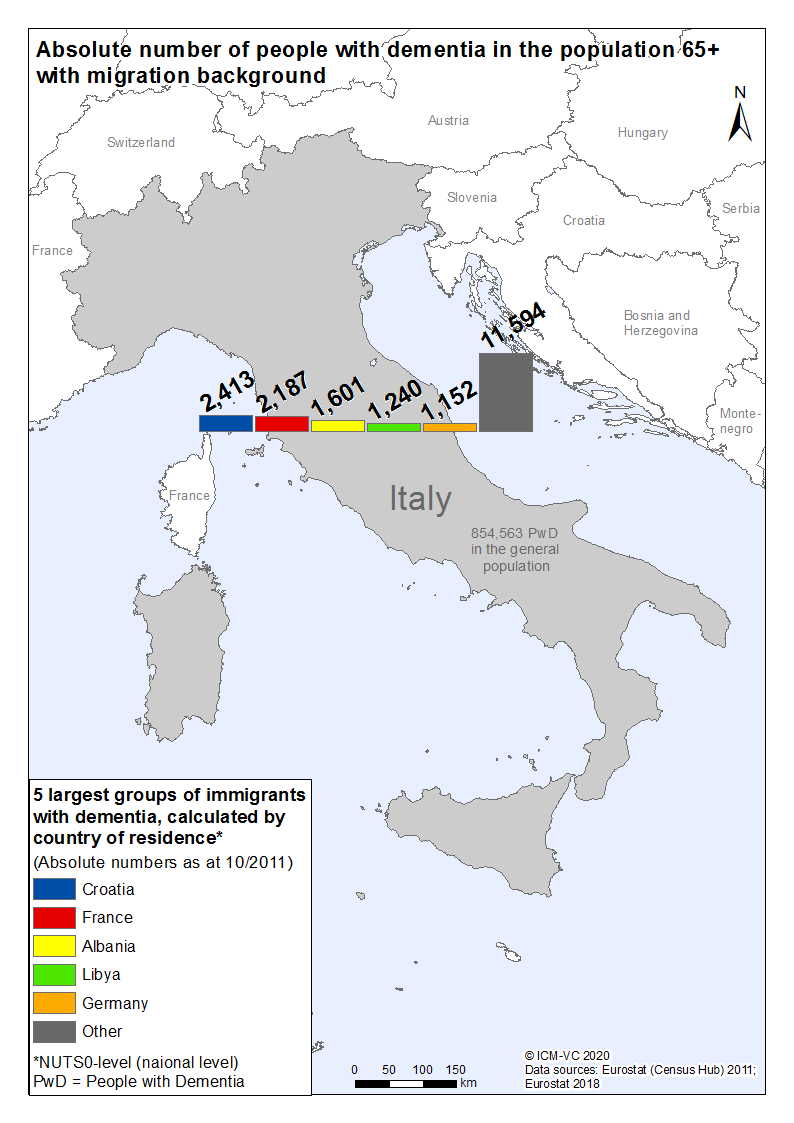EU-Atlas: Dementia & Migration
| Largest group | 2. largest group | 3. largest group | 4. largest group | 5. largest group | |
| Absolute numbers | |||||
| PwMD per 100,000 inhabitants 65+ |
| Absolute numbers | PwMD per 100,000 inhabitants 65+ | |
| Largest group | ||
| 2. largest group | ||
| 3. largest group | ||
| 4. largest group | ||
| 5. largest group |
| Prevalence per 100,000 inhabitants 65+*, calculated by country of residence | |||
|---|---|---|---|
| high > PwMD |
minor > - PwMD |
||
| increased > - PwMD |
low ≤ PwMD | ||
| medium > - PwMD |
|||
| PwMD = People with a Migration background with Dementia *Bulgarien, Litauen, Malta, Polen in der Bevölkerung 60+ |
|||
| Absolute number of PwMD 65+ | |
| PwMD per 100,000 inhabitants 65+ |
Italy
Italy went from being a country of emigration towards a country of immigration. This change happened particularly in the 1970s, when Italy had its first positive net migration since many northern European countries, after the oil crisis, adopted stricter immigration laws while Italy did not enforce its own migratory regulations. Currently, Italy continues to present the lack of migratory laws, causing a migratory population characterized by a heterogeneous configuration (192 different countries of origin) and a large number of undocumented people1. Overall, between 1990 and 2019, the proportion of migrants in the total population (2.5 to 10.4%) more than quadrupled. The net immigration rate has been continuously positive since 2000 (2020: 2.5%)2.
There are 292,600 people with a migration background aged 65 or older. Of those, approx. 20,200 are estimated to exhibit some form of dementia. The most affected migrant groups presumably originate from Croatia (approx. 2,400), France (approx. 2,200), Albania (approx. 1,600), Libya (approx. 1,200), and Germany (approx. 1,200)3.
Italy holds two official documents for the National Dementia Plan entitled ‘The New Italian National Strategy’ from 2014 and ‘National Dementia Plan - The State of the Art’ from 2019. In the first document, there is no reference to migration-related issues. Instead, it focused on dementia prevalence in Italy, existing health services and the national dementia plan objectives, actions, and future developments4. On the contrary, in the national dementia plan from 2019, there is a reference to the project called ‘Dementia in immigrants and ethnic minorities living in Italy: clinical-epidemiological aspects and public health services’ (ImmiDem). However, no further reference is made to the topic of dementia and migration5.
Italy seeks to provide an integrative care model in which people with a migration background with dementia can access existing health services. However, these services lack the necessary preparation to receive this population. Furthermore, Italy does not have specialised inpatient and outpatient healthcare services for people with a migration background with dementia, although some specific regions, such as Milan or Trento, offer cross-cultural cognitive tools and information material in various languages. Thus, measures for intercultural care or support are locally in development. However, Italy has no uniform, culturally sensitive approach to diagnostics, support and involve families in the process.
Culturally sensitive care is not part of the professional education, and professional training possibilities in intercultural care exist only as a few particular initiatives. The proportion of professional caregivers with a migration background in outpatient and inpatient care is high. Nevertheless, the need for culturally sensitive care is not being met by sufficiently qualified professionals in inpatient and outpatient care.
Family, migrant organisations, religious communities, and service providers play an essential role in supporting family caregivers. There is a high need for specialised information and services for them.
References
- Bettin G, Cela E: The evolution of migration flows in Europe and Italy. Economia Marche / Journal of Applied Economics 2014, 0(1):37-63.
- International Organisation for Migration: Net migration rate in the 5 years prior to 2020: Italy; 2019.
- Eurostat: Census 2011; 2011.
- Di Fiandra T: The new Italian National Strategy. In. Edited by Ministry of Health I. Rome; 2014.
- Bologna F: National Dementia Plan - the state of the art; 2019.


![[Translate to Englisch:] Logo RBS [Translate to Englisch:] Logo RBS](/fileadmin/_processed_/9/7/csm_RBS_Logo_RGB_0e245a98a4.jpeg)